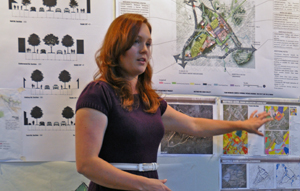UT Students Gain Real-World Experience with Regional Plan Work
Plan East Tennessee, or PlanET, is an effort to develop a shared vision for Anderson, Blount, Knox, Loudon and Union counties in the year 2040

Some early successes from the endeavor to encourage job growth, housing diversity, and preservation of the natural environment are coming from the very folks who will be among the region's leaders in 2040: a current class of local college students.
The University of Tennessee's College of Architecture and Design has pledged assistance to PlanET through a series of semester-long design studios focusing on regional issues. Two studios were undertaken in Fall 2012. One included a concept plan and illustrations for a new form-based zoning code for historic Jackson Square in Oak Ridge. The second looked at revitalization, preservation and transportation options for Maryville and Alcoa.
Professor Brad Collette, who oversees the design studios, promotes the projects as mutually beneficial to the students and their clients. "The cities are provided with visions for their communities that they may not have contemplated or considered a possibility before. They are now equipped with tangible ideas about their future growth that can stimulate meaningful, productive conversations with constituents and stakeholders," Collette said. "And the students are offered a real-life laboratory to creatively apply their studies, adding meaning to their efforts and value to the educational experience."
The Oak Ridge studio focused on Jackson Square, the city's early social and shopping center. The Square has seen many of its retail and civic occupants move to newer parts of the city, leaving behind historic buildings, many of which have fallen into disrepair. The architecture and design students worked with a UT MBA class on an economic assessment of the area. They developed the framework for a concept plan matching the type of residential, office and retail development that the city envisioned.
For the Maryville and Alcoa project, planners asked the UT students to improve street, sidewalk and greenway connections between the cities, build upon a complete streets concept for the route to Townsend, and propose new uses that would complement their downtowns.
"A significant emphasis of the Maryville-Alcoa studio was to consider an alternative to the existing low-density, single-use development pattern that is consuming our iconic regional landscapes?a growth model that considers opportunities to strengthen existing neighborhoods and redevelop underutilized sites in a manner that connects to a sense of place and redirects development away from farmsteads, rural landscapes, and natural resource areas," according to UT's Collette.
Fall semester's studios continued a trend of successful outcomes for the students. Earlier this year, a design studio resulted in a stormwater management guide that is expected to be published for local use early this year.
What will the students tackle next? Spring Semester 2013 promises a new round of design studios, so stay tuned!

